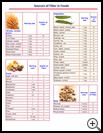
Fiber in the Diet
________________________________________________________________________
KEY POINTS
- Fiber helps keep food moving through the digestive system and softens bowel movements.
- Your child should have at least 14 grams (g) of fiber for every 1000 calories that he eats every day.
- Breads, cereals, and pasta made with whole-grain flour, brown and wild rice, oats, bulgur, and quinoa are high-fiber foods.
- When increasing the fiber in your child’s diet, it is best to do so slowly. Eating too much fiber too quickly can cause discomfort, gas, and bloating.
________________________________________________________________________
What is fiber?
Dietary fiber is the part of plants that cannot be digested. There are 2 kinds of dietary fiber:
- Insoluble fiber adds bulk to keep foods moving through the digestive system.
- Soluble fiber holds water that helps soften the stool for easy bowel movements.
If your child does not have enough fiber in his diet, he may have constipation or bowel movements that are small, hard, and dry.
Fiber is an important part of the diet even though it passes through the body. A high-fiber diet can:
- Lower cholesterol levels.
- Help your child have regular bowel movements.
- Improve blood glucose level if your child has diabetes.
- Help your child lose weight. High-fiber foods are usually lower in calories and provide a feeling of fullness.
Breads, cereals, and pasta made with whole-grain flour, brown and wild rice, oats, bulgur, and quinoa are high-fiber foods. Breakfast cereals and most grain products list the fiber content on the label so you can know which products are high in fiber.
Dried beans, peas, nuts, seeds, vegetables, and fresh or dried fruits are all good sources of fiber.
How much fiber does my child need?
Your child should have at least 14 grams (g) of fiber for every 1000 calories that he eats every day. Read the label on food packages to find out how much fiber a serving of a food provides. Foods containing more than 20% of the daily value of fiber per serving are considered high in fiber.
How can I add fiber to my child’s diet?
When increasing the fiber in your child’s diet, it is best to do so slowly. Eating too much fiber too quickly can cause discomfort, gas, and bloating. Start with small changes, like switching to whole-grain bread, and add a new source of fiber each week or two. Start the day with a high-fiber breakfast cereal.
- Encourage your child to eat more fruits and vegetables. Use carrot sticks or apple slices for snacks. Include fruits or vegetables with every meal. Cooked fiber is just as good as raw fiber.
- Serve whole-grain breads.
- Add whole grains, dried beans, and vegetables to casseroles.
- Serve fruit-based desserts.
- If your child has constipation even though you have added high-fiber foods to your child’s diet, make sure your child is drinking enough fluids. Talk to your healthcare provider if constipation continues.
Adding fiber to your diet is easy, and a high-fiber diet can provide long-term health benefits. Your child may have some gas or bloating at first, but his body will usually adjust in time.
Last modified: 2016-02-16
Last reviewed: 2017-04-10

